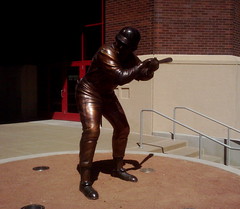
Like many aspects in the art and science of hitting, where you take your stance in the batter’s box offers as many opinions as there are fans in the ballpark. But, wherever you choose to stand in the box, it’s an important decision.
Some batters prefer standing deep in the box, while others like to be even with the plate, or have their front foot beyond the front of the plate.?Another decision is how close you want to be to the plate. ?Are you a better hitter standing on top of the plate – or a few inches, or even a few feet, off of it?
No matter the decision, it’s important to realize that you’re inevitably giving up something to get something else.
For example, crowding the plate will better allow you to handle an outside pitch, but you’ll find yourself jammed on inside pitches.?Likewise if you stand up in the box, as it will allow you to handle breaking balls better, but you’ll have more trouble catching up to fastballs.
My personal advice is to move your back leg along the backline near the inside chalk mark of the box. This will put you deep in the box and close to the plate, enabling you to wait on the pitch. With a flexible front leg, you can adjust to close or open your stance, depending on the pitcher and what he’s offering.
For me, staying back in the box bought me time, which I used to see the pitch (what it was) and where it was going.

- Image by resedabear via Flickr
Let’s explore the main distinctions of the flex-stance.
The key to the stance is the front foot; however, you must first plant your back foot. I used my back foot as a hinge and my front foot as a gate to swing open and closed, depending on the pitcher and what he was throwing.
My standard stance from the flex position, which I used roughly 80% of the time, was medium open, with my front leg eight to 12 inches from the inside chalk line. This allowed me to face the pitcher so that I had both eyes to read him. Also, my front foot is not lying on the ground like most players. Instead, my heel is elevated about two inches, increasing my mobility. The front leg is straight, but a bit loose and just firm enough to support my hip rotation. The only time that leg should lock is after contact is made and my hands are released.
The other important positions of the flex stance are open and closed stances.
The open stance will have your front foot 12 to 18 inches off the inside chalk and is used when the pitcher is throwing inside a lot or you’re facing a sidearm, curveball pitcher who throws from your side of the plate.
The closed stance will have your foot closer to the chalk line, nearly parallel to your back foot. This should be used against pitchers who try to paint the outside corners or use a fastball or slider that usually runs away from the hitter.
The most important aspect of any stance is for your front foot being mobile and fighting the urge to pull out – taking your first step away from the plate. It’s a nasty habit which also takes your head and shoulders away from the ball. It’s crucial that your first step is always up the middle, right back at the pitcher.
Editor’s Note: You can find articles from the Hall of Famer every other Thursday, right here at Baseball Reflections.com










